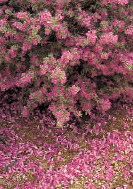
![]() chapter THREE
chapter THREE ![]()
Success with Desert Plants
Shrubs are smaller and lower growing compared to trees, so we see them in greater detail. Shrubs help bring the landscape scale down to human scale. Although many shrubs have beautiful flowers, some last for just a short while. Select shrubs for their shape, form, texture, foliage, branching habits and the substance and utility they add to your landscape.
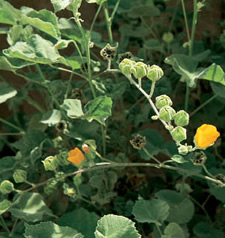
Abutilon palmerii, desert abutilon, indian mallow.
Abutilon palmerii
desert abutilon, indian mallow

Grows up to 5 feet high and as wide with an upright and open form. Velvety heart-shaped leaves and flowers like hollyhocks lend an almost tropical quality. Plants tolerate hot, dry conditions but soak the root zone every week or so in summer to maintain appearance. Appreciates afternoon shade. Much less water is needed in the cool seasons of the year. Native to Sonoran Desert.
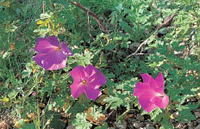
Alyogyne huegelii, blue hibiscus.
Alyogyne huegelii
blue hibiscus


An attractive member of the mallow family, this plant grows to 5 feet high and spreads to 4 feet wide. It can also be pruned to become a small tree. Blue-purple flowers bloom from spring into fall, the individual blooms lasting two to three days. Does best in afternoon shade or on the north side of a building. Pinching back branches can increase flowering, but avoid shearing or topiary pruning. If damaged by frost, wait until spring to prune damaged branches. Accepts container culture, and must have well drained soils. Keep in mind that the dark green leaves are covered with tiny hairs that can irritate sensitive skin. ‘Santa Cruz’ produces an attractive, deep blue flower. Native to coastal southwestern Australia.
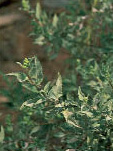
Ambrosia deltoidea, triangle leaf bursage.
Ambrosia deltoidea
triangle leaf bursage

This small evergreen shrub is primarily used for revegetation and erosion control. It reaches 1 to 2 feet high and as wide, with a naturally rounded form, featuring silvery gray foliage. Moderately rapid growth. Once established it can survive with only an occasional watering, but better appearance with summer waterings. Flowers are small and insignificant. A relative of ragweed, some people are allergic to its pollen. Native to southern Arizona.
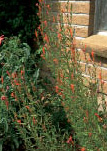
Anisacanthus species, desert honeysuckle.
Anisacanthus species
desert honeysuckle

Two Anisacanthus species share the common name of desert honeysuckle. Hummingbirds and butterflies flock to the tubular, nectar-filled flowers of both species. Plants are semideciduous and excellent for wildlife habitats. Plants grow 3 to 5 feet high and as wide with a natural, open form. Cut plants back to 12 inches in late winter for renewed growth in spring. Well-drained soil is necessary.
Anisacanthus quadrifidus var. brevifolius ‘Mexican Fire’™ and A. quadrifidus var. wrightii ‘Mexican Flame’™ are grown for their abundant orange flower clusters. Most flowering occurs midsummer until frost. Both are hardy to 10°F. Parents are native to Chihuahuan Desert.
A. thurberi produces orange or yellow tubular flowers that bloom in spring and summer. Hardy to 20°F. Native to Arizona and New Mexico.
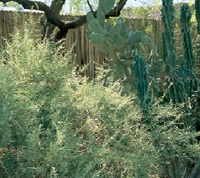
Atriplex canescens, fourwing saltbush.
Atriplex canescens
fourwing saltbush


This plant is a “must” for the wildlife garden. Birds, especially native quail, appreciate the dense cover and edible seeds it provides. Silvery blue-green, evergreen leaves are actually covered with microscopic plates of white wax, which helps the plant conserve water. Plants reach 4 to 8 feet high and as wide. Clusters of inconspicuous yellow flowers bloom in summer, and are followed by golden fruit pods with four wings on them. Well adapted to salty conditions, and effective for erosion control. Native to western North America.
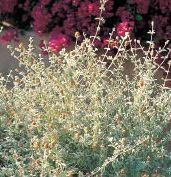
Buddleia marrubifolia, woolly butterfly bush.
Buddleia marrubifolia
woolly butterfly bush

Useful as a backdrop to perennial beds, the small, ball-shaped, yellow and orange flowers attract butterflies in summer. Grows to 5 feet high and as wide. The toothed, silvery gray, woolly leaves blend and contrast well with silver or green leaved plants such as brittlebush, lavender, red salvia and bougainvillea. Plant in soil with good drainage. Prune in late winter to control or renew plants. Native to the Chihuahuan Desert in Mexico.
Buxus microphylla
var. japonica
japanese boxwood


Boxwood grows to 6 feet high and as wide with a rounded form. It accepts shearing and is a favorite hedge or topiary plant. Leaves are small, round-tipped, bright green and have a musky odor. Accepts sun to partial shade. Native to Japan.
‘Nana’ is evergreen and compact 2 to 4 feet high.
Caesalpinia species
Bird of Paradise
These are tropical plants with bright green, feathery foliage. Leaves and branches can suffer frost damage below 30°F. The roots can tolerate temperatures into at least the upper teens. If healthy before a freeze, plants recover rapidly in spring, growing back bushier than ever. Wait until danger of frost has past in spring before pruning damaged branches.
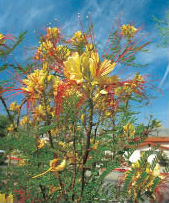
Caesalpinia gilliesii, yellow bird of paradise.
Caesalpinia gilliesii
yellow bird of paradise


Grows 6 feet high, with an equal spread. Foliage is sparse and feathery, with a growth habit that can become top heavy. Spikes of large, brilliant yellow flowers with showy red stamens are the payoff for growing this plant. Best used as a background behind smaller, fuller plants to hide the bare lower stems. Provides color late spring to fall. Accepts shade. Tolerant of almost any soil. Native to Argentina.
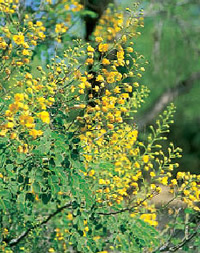
Caesalpinia mexicana, Mexican bird of paradise.
Caesalpinia mexicana
mexican bird
of paradise

This yellow-flowering species has recently become available. It grows rapidly to 10 feet high and as wide. The bloom season comes on slightly later than red bird of paradise, and lasts later in the year. Foliage freezes at 28°F to 30°F, but healthy plants recover from the roots. Accepts some shade. Native to Mexico.
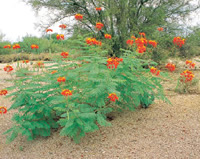
Caesalpinia pulcherrima, red bird of paradise.
Caesalpinia pulcherrima
red bird of paradise


Brilliant red and yellow flowers bloom from early summer to fall. A splendid workhorse plant for the Coachella Valley. Typically grows 5 to 8 feet high, with fine-textured, almost luxuriant leaves, but can get much larger in mild climates. Due to its stature and deciduous nature, use as a background plant. Accepts almost any soil but full sun is required. Cut stems back to about 18 inches after winter dormancy, prior to new spring growth. Native to the West Indies.
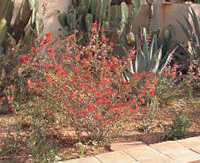
Calliandra californica, Baja fairy duster.
Calliandra californica
baja fairy duster

The refined, dark green foliage of Baja fairy duster is attractive when combined with other natives or subtropical plants. It grows to 6 feet high and 4 to 5 feet wide with an open form. Red puffball flowers with long stamens bloom spring into fall; attracting hummingbirds. Prune lightly in late spring to encourage a fuller plant from the ground up. If growth becomes excessive, decrease water. Plant in soil with good drainage. Native to Baja California.
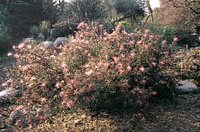
Calliandra eriophylla, fairy duster.
Calliandra eriophylla
fairy duster

Produces pinkish red flower clusters in the spring, complemented nicely by its refined foliage. Mature height and spread is 2 to 3 feet. Similar to Calliandra californica, but its growth habit is typically more controlled. Graceful and airy, it is ideal in a natural garden design. Pruning back branches slightly may help create more fullness. Allow plants to grow naturally and they will produce more flowers. A low water-use plant that prefers full sun and well drained soil. Native to Sonoran and Chihuahuan Deserts.
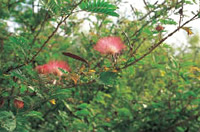
Calliandra haematocephala, pink powder puff.
Calliandra
haematocephala
pink powder puff

A desirable, hospitable evergreen for an unusual accent planting or trained along a wall. Accepts some shade. Grows in a sprawling form to 10 feet high and as wide. In winter, a profusion of bright, red-pink stamens shaped like huge powder puffs contrast with rich green, compound leaves. Attracts hummingbirds. Plant in well-drained soil. Native to Bolivia.
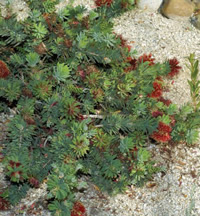
Callistemon viminalis 'Little John', little John bottlebrush.
Callistemon viminalis ‘Little John’
little john bottlebrush

The species Callistemon viminalis is a commonly grown tree. ‘Little John’ is an attractive shrub to 3 feet high and as wide. The narrow, light green leaves grow up to 6 inches long. Profuse numbers of red bottlebrush flowers bloom fall into spring. They attract butterflies and hummingbirds. Acidify the soil on a quarterly schedule to prevent chlorosis and to encourage more flowers. A hybrid of Australian parents.
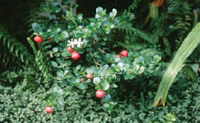
Carissa grandiflora 'Tutteli', natal plum.
Carissa grandiflora
natal plum

(C. macrocarpa). This commonly grown shrub reaches up to 7 feet high and as wide. Leaves are an intense deep green, densely arranged on unique, tight, short branches. Makes a suitable hedge but spines can be a hazard. Protect from frost by locating in a warm microclimate such as the south side of a building under a wide overhang. It accepts some shade. Fragrant white flowers are followed by red or purple fruit—as long as plants are not pruned excessively. Native to South Africa.
‘Boxwood Beauty’ has a compact, shrubby form, growing to 2 feet high. ‘Fancy’ has outstanding fruiting qualities and boldly branching, upright growth to 6 feet high. ‘Green Carpet’ has dense growth to 1-1/2 feet high. Its spreading habit makes it exceptionally good as a ground cover. Foliage is lush and resembles a carpet of green. ‘Tuttlei’ has a more upright form to 2 to 3 feet high. It has a spreading, tight-branching growth habit enhanced by its rich green foliage.
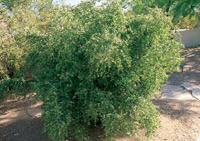
Celtis pallida, desert hackberry.
Celtis pallida
desert hackberry

From a distance, the overall impact of this shrub is a dense, medium green, rounded form to 8 feet high and 10 feet wide. Up close, the spines reveal themselves. Fragrant yellow flowers bloom in spring, followed by orange berries in fall. The dense growth and spines, combined with highly edible berries, make this a favorite nesting place for many desert birds. In the landscape, desert hackberry makes a wonderful informal hedge, screen or ideal backdrop for showier plants. It can also be used for erosion control. Extra water in spring and summer promotes more flowers and fall fruit. Native to sandy soil locations from west Texas into Arizona.
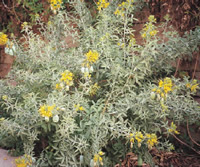
Cleome isomeris, bladderbush.
Cleome isomeris
bladderbush

(Isomeris arborea). This 4- to 6-foot shrub has light green foliage and bright yellow, snapdragonlike flowers borne in clusters at the tips of branches. Flowers are a great source of nectar for bees and hummingbirds. After flowers complete bloom, inflated green capsules develop with seeds inside. Plants blend well with Encelia farinosa, Aniscanthus species and Salvia greggii. Easy to grow from seed sown directly in place. Well-drained soil is important. Avoid overwatering during its summer dormancy. Native to the western Mojave Desert.
Cocculus laurifolius
laurel-leaf cocculus


Glistening leathery leaves to 6 inches long on graceful, arching branches make this upright, evergreen shrub a desirable addition to the landscape. Develops slowly to 25 feet high. Accepts pruning well. Good cut foliage for arrangements. Accepts some sun but better with eastern exposure (afternoon shade) or in partial shade beneath canopy trees. Native to Himalayas.
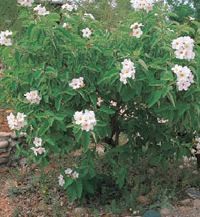
Cordia boissieri, Texas olive.
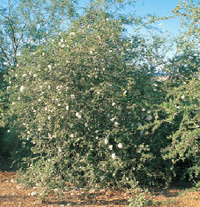
Cordia parvifolia, little-leaf cordia.
Cordia boissieri
texas olive

This superior shrub has blue-green, leathery leaves and clusters of white flowers to 2-1/2 inches wide. Grows 10 to 12 feet high and spreads to 10 feet wide. Generally a warm-season bloomer, however, flowering extends into winter in the mild climate of the Coachella Valley. Accepts partial shade. Prefers well-drained soil. Remove dead interior branches and lower branches for a small tree form. Native to Mexico and the Rio Grande Valley in Texas.
Cordia parvifolia, little leaf cordia, is similar to C. boissieri but smaller in stature and texture with smaller leaves and white flowers 1 to 1-1/2 inches across. Plants grow 4 to 6 feet high with a similar spread. Form is more open and airy. They can become cold-deciduous below 20°F.
Cuphea hyssopifolia
false heather, mexican heather


A compact shrub to 2 feet high and as wide. The tiny, bright green, needlelike leaves look similar to true heather. Small, starlike flowers in pink, purple or white appear for most of the warm season. Often grown as a seasonal hanging basket, it does better planted in the ground where roots appreciate the cooler temperatures. Plant in well-drained soil. Native to southern Mexico and Guatemala.
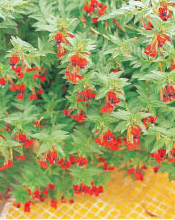
Cuphea llavea, bat-faced cuphea.
Cuphea llavea
bat-faced cuphea


Small shrub to 2 feet high and 3 feet wide with crisp, dark green foliage. Blooms spring, summer and fall. Unusual red flowers with purple centers remind one of a bat’s face. Provide ample water during warm months, particularly if plants are located in full sun. Best with afternoon shade in the Coachella Valley. A longer-lived alternative to annuals in flowerbeds. Native to Mexico.
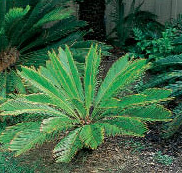
Cycas revoluta, sago palm.
Cycas revoluta
sago palm


(Cycas ehrenbergia). A dwarf and compact, palmlike plant, with many, long, shining, dark green leaves. The leaves appear as if they’ve been waxed, growing as a crown on top of the short trunk. The thick, heavy stem in small plants resembles a pineapple. Makes a splendid specimen container plant or include in a grouping of similarly sized palms. Reaches choice height of 6 to 10 feet high and 6 feet wide, but grows very slowly. Locate where plants receive partial filtered shade; protect first year with shade cloth to keep direct sun off plant. Native to Japan.
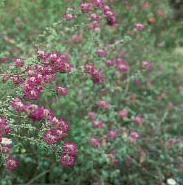
Dalea frutescens, black dalea.
Dalea frutescens
black dalea

One of the many valuable Dalea species. Compact to 3 feet high and 4 feet wide. Expect partial leaf drop in extreme cold or during drought. Rose-purple flowers put on a show in fall and winter when most plants have ceased blooming. Lightly prune, maintaining natural form, in spring. Plant in well-drained soil. ‘Sierra Negra’ has more prolific blooms. Native to Chihuahuan Desert.
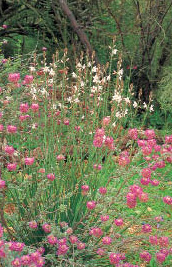
Dalea pulchra, indigo bush.
Dalea pulchra
indigo bush, bush dalea

This shrub has contrasting, intertwining, silvery gray leaves with violet-blue flowers from late winter into spring. Grows 3 to 5 feet high and up to 4 feet wide. Adds great interest when combined with other native desert plants. Best in full sun and in well-drained soil. Native to Arizona and northern Sonora, Mexico.
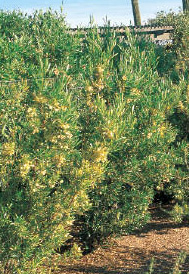
Dodonaea viscosa, hop bush.
Dodonaea viscosa
hop bush

A ruggedly handsome substitute for oleander, or wherever you need a vigorous, fast-growing shrub or screen. Reaches 10 to 12 feet high and almost as wide, with bright green, evergreen leaves. Suitable as low windbreak or for screening. Space 4 to 5 feet apart. Will accept some shade, and stands up to wind, heat and cold. Flowers are inconspicuous but are followed by showy, pale yellow seed pods that split and blow away—low litter. Lightly shape plants (avoid shearing), or allow them to develop their natural form. Native to Arizona.
‘Purpurea’, purple hop bush, has bronzy purple leaves and is less hardy—to 20°F.
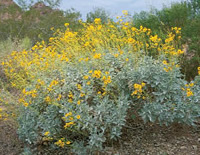
Encelia farinosa, brittlebush.
Encelia farinosa
brittlebush, incienso

Brittlebush is an abundant shrub in natural desert areas throughout the Sonoran and Mojave Deserts. It plays a versatile role in home gardens, particularly in natural designs with other native plants. Evergreen gray to light green leaves are soft and velvety to the touch, covering the 2- to 3-foot plants. Bright, yellow, daisylike flowers are borne on tall stems in profuse numbers well above the foliage in spring. After flowering has passed, cut plant back by one-third and water thoroughly for a repeat bloom. Little is required to grow them successfully: well-drained soil, low water and full sun. Does not need fertilizer. May die back to the ground during periods of drought, but generally comes back with moisture.
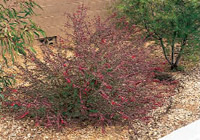
Eremophila maculata v. brevifolia, red eremophila.
Eremophila maculata v. brevifolia
red eremophila

An excellent choice for bright winter color. The dark gray leaves are virtually hidden by the brilliant red flowers January into March. The rest of the year, the symmetrical, 4- by 4-foot, dark gray shrub blends with other silvery foliaged plants. Grows moderately fast and prefers well drained soils. Shear plants in April after blooming, but then not again if you want ideal bloom display.
Also try Eremophila ‘Summertime Blue’ for its lilac-blue flowers during summer. It also has an ability to grow in clay soils. Both are native to Australia.
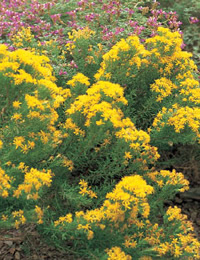
Ericameria laricifolia, turpentine bush.
Ericameria laricifolia
turpentine bush

In the fall, the dense, fine-textured, dark green leaves of turpentine bush become blanketed with bright yellow, daisylike flowers. The refined growth can develop into a shrub 2 to 3 feet high and as wide. Best used in masses or groups in out-of-the-way places, on slopes or in combination with other low-water use plants. Give the foliage a rub between your hands and you will smell the turpentine scent. Native to west Texas, New Mexico, Arizona and Mexico.
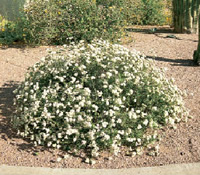
Eriogonum fasciculatum v. poliofolium, flattop buckwheat.
Eriogonum fasciculatum v. poliofolium
flattop buckwheat

A low, rounded, evergreen shrub to 1 1/2 feet high, spreading to 2 feet wide. Leaves are extremely fine textured—dark gray-green above, white and woolly below. This delicate foliage is virtually hidden in spring by 2-inch clusters of tiny white to pale pink flowers. Flowering begins in March and can continue into November if plants receive regular water. Seeds are loved by the lesser goldfinch and other birds. Pruning generally isn’t necessary. Does best in well drained soils—it is native to dry rocky slopes of southeastern California, and into Arizona and Nevada.
Euonymus japonicus
euonymus

Fast-growing, upright shrub from 8 to 12 feet high with large, shiny, deep green leaves. Needs regular moisture to maintain healthy, overall lush and vigorous appearance. Compact branching habit accepts shearing well. Native to Japan.
‘Aureo-variegata’, gold spot euonymus, grows to 10 feet high and 6 feet wide. It has leaves blotched with yellow and well-defined, dark green margins. Best in partial shade. ‘Microphyllus Improved’, boxleaf euonymus, is a dwarf selection 1 to 2 feet high. It is erect but compact with small, closely arranged, dark green leaves. Formal appearance that does not require pruning. Locate in full sun or partial shade.
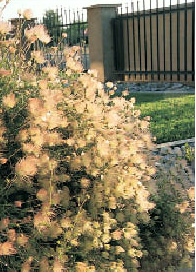
Fallugia paradoxa, Apache plume.
Fallugia paradoxa
apache plume

Apache plume grows 3 to 6 feet high and as wide. Admired for its graceful, airy, upright, angular branches covered with dark green leaves, as well as its flowers and seed heads. Flowers are 1 inch across and look similar to single rose blossoms. Seed heads that are silky pink plumes adorn plants from May to December. Adds long-term interest throughout the landscape. Deciduous in cold winters. Locate in full sun to partial shade. Well-drained soil essential. Native range extends from Utah to Texas south to Mexico.
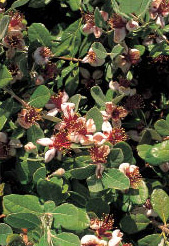
Feijoa sellowiana, pineapple guava.
Feijoa sellowiana
pineapple guava

This is a fast growing, evergreen shrub, reaching 10 to 18 feet high. Gray-green leaves are attractive, as are the waxy white flowers with red stamens. Flower petals are edible and can be used in salads. Flowers bloom May through June and are followed by tasty fruit. Fruit quality and quantity is better in cooler climates, and when fruit-producing cultivars are grown. Accepts some shade. Native to South America.
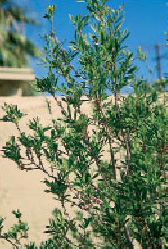
Fraxinus greggii, little leaf ash.
Fraxinus greggii
little leaf ash

Grows at a moderate rate to 10 feet high and up to 8 feet wide. Leaves are light green to gray-green; bark is gray. Can be trained to become a small tree with rounded head. Tolerates heat, alkaline soils and lawn situations. Native to canyon bottoms and steam sides, so does best with regular water. Inconspicuous spring flowers are pollinated by the wind. Ash are in the same family as olives, and their pollen is troublesome for some. Native from Arizona to Texas.
Gardenia jasminoides
gardenia

(Gardenia angusta). Evergreen shrub 3 to 4 feet high and as wide, grown for its famous, large, creamy white and extremely fragrant flowers. The flowers, framed by glossy green leaves, bloom April to October. Apply acidifying fertilizer monthly from March to September for best results. Good soil drainage is required. Prefers partial shade. Suited to containers. Native to China, Taiwan and Japan.
‘Mystery’ is bushy and compact to 5 feet high. ‘Veitchi’, everblooming gardenia, is free-flowering, compact and upright to 3 feet high.
Grewia occidentalis
lavender star flower

Fast-growing, evergreen shrub to 6 feet high, spreading 4 to 5 feet wide. Dark green, 3-inch-long leaves serve as an excellent backdrop to the lavender, star-shaped flowers that bloom late spring into fall. Tolerates wind. Do any major pruning in fall after bloom ceases. Accepts training as an espalier. Native to southern Africa.
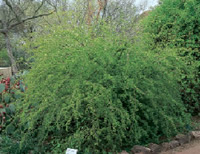
Guaiacum coulteri, guayacan.
Guaiacum coulteri
guayacan

Intense, blue-purple flowers offer a startling splash of color against the rich, dark green foliage. Flowers appear in spring and can last into midsummer if plants are given a little extra water. The leaves are composed of 6 to 10 tiny leaflets and are borne on twisted, crooked branches covered with smooth, pale gray bark. Prefers well drained soil. Accepts some shade. Susceptible to hard frosts, growing at a moderate rate to 6 feet high and as wide. In frost-free areas it can reach up to 10 feet high. Native to tropical deciduous thorn scrub of western Mexico.
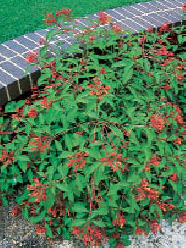
Hamelia patens, scarlet bush.
Hamelia patens
scarlet bush, fire bush

This fast growing shrub has fuzzy, 6-inch, gray-green leaves. In areas with frost, plants reach 5 feet high and as wide, but often remain smaller. In frost-free areas in the tropics they can reach an incredible 25 feet. Clusters of orange-red, 3/4-inch tubular flowers bloom through summer with regular moisture. Flowers are followed by small dark fruit that are relished by birds. Needs good soil drainage, but tolerant of saline soils. Accepts some shade, but protect from wind and frost. Prune in fall after flowering has ceased. Native to southern Florida and Central America.
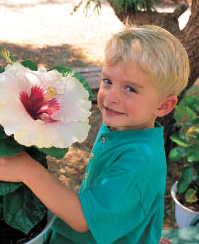
Hibiscus ‘High Voltage’.
Hibiscus rosa-sinensis
hibiscus


These subtropical flowering shrubs grow 6 to 10 feet high, and bloom continuously during the warm season. Foliage varies but most have attractive, glossy, deep green leaves. Flowers come in a wide range of colors; many are multicolored with contrasting throats. Well-drained soils are a must. Locate plants where they’ll receive afternoon shade and wind protection. Prune in early spring, and pinch spent flowers through the flowering season to encourage more blooms. Hardy to 28°F to 40°F, depending on variety. Native to tropical areas around the world.
Some common cultivars include:
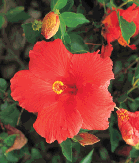
Hibiscus ‘Agnes Gault’.
‘Agnes Gault’—large, single, bright, rose-pink flowers that are heavily veined with a pink and cranberry throat. Fast-growing, vigorous plant. Prune to prevent legginess. ‘Butterfly’—vibrant, bright yellow, single flowers are produced in profusion on slow-growing, upright plants. ‘Crown of Bohemia’—very full double flowers are magnificent golden yellow with deep orange-red throats, on upright plants to 5 feet high. ‘High Voltage’—large white flowers with contrasting magenta throats. ‘Ross Estey’—extremely large single flowers with orange edges shading to glowing rose center. The ruffled and tufted flowers last about three days on plants. Vigorous growth to 8 feet high. ‘San Diego Red’—vivid, bright red single flowers in profuse numbers most of the year. ‘White Wings’—heavy crop of attractive single flowers. White petals have a ruby eye in the center accented with a faint red vein in each petal. A vigorous plant, prune to control legginess.
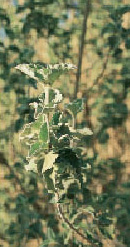
Hyptis emoryi, desert lavender.
Hyptis emoryi
desert lavender


The wonderful lavender fragrance of all parts of this shrub make it an excellent addition to any garden. The powder gray foliage contrasts well with clusters of small violet-purple flowers that grace the bushes from spring through fall. They cling, dried on the stems, through the winter. Becomes an open, upright, vase-shaped, evergreen shrub, reaching 5 to 8 feet high, eventually spreading as wide. Plants are winter dormant, and require no water during this season. Plant in the background for an excellent backdrop to perennials, wildflowers or other color plants. Does best in well drained soil. Native to Sonoran Desert.
Ilex vomitoria ‘Stokes Dwarf’
dwarf yaupon

Tiny, rich, dark green leaves are closely held on a dwarf plant from 2 to 3 feet high. Tolerates alkaline soils better than other hollies. Use as a border or low hedge. Accepts some shade. Native to southeastern United States.
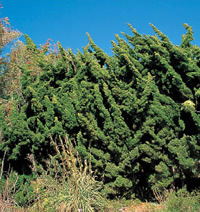
Juniperus chinensis 'Torulosa', Hollywood juniper.
Juniperus chinensis
juniper

Junipers are available in many different sizes, forms, growth habits and foliage colors. Research carefully to get the plants you want to fit your use and site. Some will accept partial shade.
‘Armstrongii’, Armstrong juniper, is a showy, compact, semi-erect conifer from 4 to 5 feet high. Symmetrical with a close-knit growth habit. Attractive, medium green, lacy-textured foliage.
‘Hetzii Columnaris’, a columnar juniper, is an attractive, bright green shrub, growing as a dense, 12- to 15-foot column. Sharp-pointed, needlelike leaves accept trimming well.
‘Pfitzeriana’, Pfitzer juniper, has handsome, gray-green foliage. Sharp-needled leaves cover arching branches as plant develops into a showy, spreading shrub 6 to 10 feet high and as wide. Its form creates a natural security barrier that is difficult to penetrate.
‘San Jose’ is one of the best prostrate (low-growing) junipers. Dark sage green foliage with a compact growth habit to 2 feet high, spreading to 6 feet wide. it becomes a husky presence with many branches. Locate in partial shade. Excellent specimen for tub or bonsai.
‘Torulosa’, also known as ‘Kaizuka’, Hollywood juniper, has rich green foliage. Form is upright from 10 to 15 feet high. Erect branches take on a picturesque, wind-blown appearance. Best in partial shade. Handsome shrub for use along fences or as an accent.
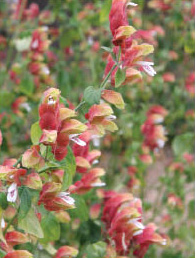
Justicia brandegeana, shrimp plant.
Justicia brandegeana
shrimp plant


(Beloperone guttata). Masses of pinkish copper, shrimp-shaped bracts, modified leaves, surround small white flowers set off by evergreen, apple green leaves. Plants grow 2 to 3 feet high and as wide, blooming during the warm season. Best in partial shade. Good for a tropical effect. Can be planted in containers. Cut cold-damaged plants back in early spring to rejuvenate them. Native to Mexico, it has escaped and naturalized in southern Florida.
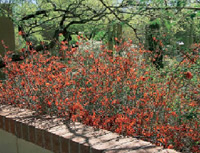
Justicia californica, chuparosa.
Justicia californica
chuparosa

Showy, red, tubular flowers are most profuse in the spring, with sporadic flowers in summer and fall. Sprawling, informal growth to 4 feet high, spreading to 6 feet wide, with small, pale green leaves. Ideal for a hummingbird garden or a natural garden design. Cut plants back severely in early spring every two or three years to reinvigorate growth. A yellow-flowering form is also available. Native to the Sonoran Desert.
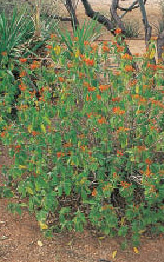
Justicia spicigera, Mexican honeysuckle.
Justicia spicigera
mexican honeysuckle


Vivid, orange, tubular flowers combine with soft, fuzzy, pale green leaves, creating a luxuriant effect. Hummingbirds flock to plants when in bloom in mid- to late spring, and into fall with regular water. Growth is rounded to upright to 4 feet high. Usually no insect or disease problems. Tolerates some sun, but grows best in filtered shade, such as beneath high-canopied trees. Native to southern Mexico and into Central America.
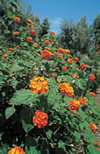
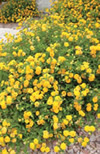
Lantana camara, lantana. 'New Gold' right.
Lantana camara
lantana

Evergreen shrub or ground cover. Produces masses of color during the warm season, blending with native or introduced dry-climate plants. Rich green leaves cover the thickly branched plants. Cut plants back severely in early spring every two or three years to renew growth. Native to tropical America.
Many outstanding selections are available: ‘Christine’, striking cerise-pink flowers; ‘Cream Carpet’, cream-colored flowers; ‘Dwarf White’, velvety white flowers; ‘Dwarf Yellow’, bright yellow flowers; ‘New Gold’, golden yellow flowers; Radiation’, rich, orange-red flowers; ‘Spreading Sunset’ with vivid, orange-red flowers; ‘Spreading Sunshine’, abundant, bright yellow flowers create a blanket of color on low, spreading compact plants; ‘Tangerine’, produces blooms that have a true, solid tangerine color.
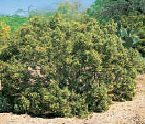

Larrea tridentata, creosote bush.
Larrea tridentata
creosote bush


(L. divaricata). This characteristic shrub of the desert can be seen in abundance throughout low- and high-elevation regions of the desert Southwest. The fresh, clean scent this plant produces after a rain is unique, and treasured by desert dwellers. It is one of the most versatile shrubs for a natural garden design, accepting the toughest conditions of intense heat, sun, wind, cold and drought. The olive green, glossy, evergreen foliage can be most useful as a hedge or screen or individual specimen. Creosote is truly maintenance-free. Bees are attracted to small yellow flowers that cover the 5- to 12-foot plants in spring.
To help plants develop deep tap roots, provide new plantings with deep irrigation, but allow the soil to dry between applications. If you have inherited creosote bush on your property, an occasional deep irrigation will cause plants to produce more luxuriant growth. Light pruning may be necessary if plants become scraggly.
Leucophyllum species
Texas Ranger
This genus of flowering shrubs have become star performers in Southwest landscapes. More than a dozen species and selections are available and adapted to a large region, from Texas to California. Plants come in a range of sizes and have evergreen, silvery gray to green foliage and dense, well-rounded growth. Low water use, acceptance of full sun and long flowering seasons are more than enough attributes to use them in abundance in most any garden situation. Each species has a unique value that makes it worthy of consideration. Native to the Chihuahuan Desert, most selections are generally cold hardy to 10°F and have few problems caused by insects or diseases. Good soil drainage is important; avoid overwatering.
Allowed to grow naturally, plants take on an informal appearance. Controlling growth by trimming creates a more dense, hedgelike appearance, but usually results in fewer flowers and higher water use. Avoid pruning in globes or squares. Prune lightly in fall after the flowering season has finished to maintain the plant’s form and for a more natural but controlled effect.
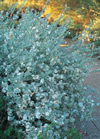
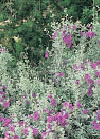
Leucophyllum candidum
('White Cloud' left, 'Silver Cloud' right).
Leucophyllum candidum
violet silverleaf


Plants found in Texas were brought to the nursery trade due to the gorgeous silvery foliage and smaller stature (3 feet high and wide) compared to other Leucophyllum species. Flowers are deep violet, striking in contrast against the silver leaves. Most prolific bloom comes in late summer.
‘Silver Cloud’ has striking, dark violet flowers, excellent in contrast to its silvery, almost white foliage. It is larger than ‘Thunder Cloud’ but produces fewer flowers. ‘Thunder Cloud’ grows to 2 feet high with indigo flowers.
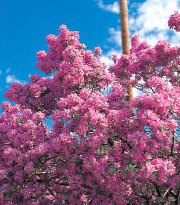
Leucophyllum frutescens, Texas ranger.
Leucophyllum frutescens
texas ranger


This is the species that was the first Leucophyllum to be brought into cultivation. It grows 6 to 8 feet high and as wide with a slightly rangy, open growth habit. Becomes an excellent screening hedge, and an alternative to oleander. Rose-purple flowers bloom most profusely in midsummer against a backdrop of blue-gray leaves. Native to Texas into Mexico.
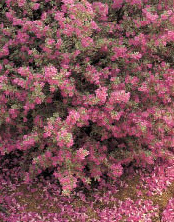
Leucophyllum frutescens 'Green Cloud'.
‘Compacta’ develops into a dwarf shrub 3 to 4 feet high. ‘Green Cloud’ has light green foliage; ‘White Cloud’ produces gray foliage and white flowers. ‘Rain Cloud’ is a cross between L. frutescens and L. minus. Foliage is similar to L. frutescens but flowers are a brilliant shade of violet-blue.
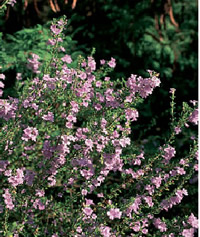
Leucophyllum laevigatum, Chihuahuan rain sage.
Leucophyllum laevigatum
chihuahuan rain sage


Grows to 4 feet high and as wide or wider with light violet flowers that bloom during summer, especially with humidity. Small, wavy, medium green leaves cover the branches, which turn up at the ends. Native to canyon bottoms in the Chihuahuan Desert.
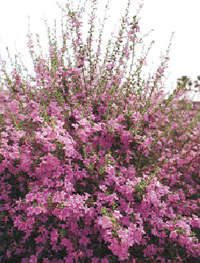
Leucophyllum langmaniae 'Rio Bravo'.
Leucophyllum langmaniae
cinnamon sage


Grows to 5 feet high and as wide with leaves that are similar to Chihuahuan rain sage but plants have a denser form. Flowers are violet and appear through the summer. ‘Rio Bravo’ has improved flowering performance. Native to Chihuahuan Desert.
Leucophyllum pruinosum
sierra ranger


A charming plant with silvery white leaves and deep purple flowers that are the most fragrant of the Texas rangers. Grows to 6 feet high with an equal spread, making it an excellent background plant or screening hedge.
‘Sierra Bouquet’ is an especially striking and fragrant plant—its flowers smell like grape bubblegum. Native to the Chihuahuan Desert.
Leucophyllum zygophyllum
blue ranger

Grows slowly to 4 feet high and as wide with a naturally rounded form. Leaves are a silvery blue-green and are distinctive in that they cup upward. Light blue-violet flowers are attractive and appear intermittently through the warm season.
‘Blue Ranger’ features flowers that are a darker, blue-violet hue. ‘Cimmaron’ , with light blue flowers, becomes a compact shrub 3 to 4 feet high and as wide. Native to southwest U.S. into Mexico.
Ligustrum japonicum
japanese privet, waxleaf privet


(L. texanum). Fast growing, evergreen shrub or small tree 8 to 12 feet high and as wide. Dark green, lustrous leaves on heavily branched, upright habit. Clusters of white flowers bloom in spring. Can be sheared into topiary forms, also makes a wonderful hedge or screen. Avoid full sun situations because leaves are subject to sunburn. Native to Japan and Korea.
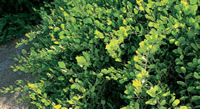
Maytenus phyllanthoides, mangle dulce.
Maytenus phyllanthoides
mangle dulce

This large evergreen shrub forms a dense, lush screen with minimal care or effort. Grows at a slow to moderate rate to 10 feet high with an equal spread. Bright green, leathery leaves are rounded and fleshy, and are attractive all year long. Inconspicuous spring flowers are followed by small red fruit that add a dash of color, and are enjoyed by birds. Accepts some shade. Plants are native to salty soil regions of coastal Texas and Baja.
Murraya paniculata
orange jessamine

Luxuriant, bright, glossy green leaves and waxy, pure white flowers bloom April to July. They perfume the air with an intense, orange blossom fragrance. Makes an attractive evergreen hedge or screen 6 to 12 feet high. May take on a tree form ranging to 20 to 25 feet with time, if not pruned. Best appearance if given some shade but tolerates full sun with ample water. Native to southeast Asia.
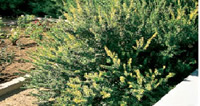
Myrtus communis, true myrtle.
Myrtus communis
true myrtle

Grown for its aromatic, dark green, glossy leaves, this shrub has white flowers in the spring and summer, followed by dark blue berries. Ideal hedging plant and natural foundation plant to 10 feet high, it also accepts shaping well. Accepts some shade. Native to the eastern Mediterranean.
‘Compacta’, dwarf myrtle, has smaller leaves and a more compact growth habit to 3 to 4 feet high—ideal for low hedging or foreground planting.

Nandina domestica, heavenly bamboo.
Nandina domestica
heavenly bamboo

This compact, evergreen shrub grows 5 to 8 feet high. It is a highly versatile plant for small areas. Appearance is bamboolike, with many vertical stems that display distinctive, lacy green leaves. Foliage may turn brilliant shades of red and orange in fall, depending on extent of exposure to sun and cold. Red berries in winter are also an attraction. Great decorative value in containers. Best with eastern or northern exposure; don’t plant on the sunny west side. As plants age, remove old stems to renew growth, otherwise little maintenance required. Dwarf selections are available. Native to India and east Asia.
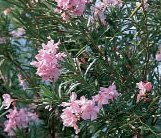
Nerium
oleander, oleander.
Nerium oleander
oleander

Oleander has long been a workhorse plant in the Coachella Valley, useful as windbreaks and screens. But oleander leaf scorch—a bacterial disease—and canker— a bacterial infection—are destroying mature plantings throughout California and the Southwest. Currently, older plants, 20 to 30 years old, are most affected. There is no known cure. At this time it is recommended that other plants be grown.
If you have healthy, existing plantings, continue to maintain them as usual. Prune during warm weather, dipping clippers into a 10 percent bleach solution between cuts. Pruning exposes the interior of the plant to sunlight, stimulating new flowering wood. Do not prune into globes or squares. Avoid shearing, which reduces flowering wood. Note that all plant parts are poisonous so do not burn wood—the resulting smoke may cause irritation.
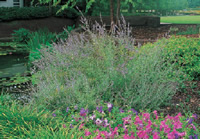
Perovskia atriplicifolia, Russian sage.
Perovskia atriplicifolia
russian sage

This is an underused plant that blends well with Rosmarinus, Salvia, Encelia and Ericameria species. It grows 3 to 4 feet high and as wide. Stems with small, toothed, gray-green leaves are topped with showy spikes of diminutive lavender flowers in the summer. Selections that produce flowers in different colors are available. Well-drained soil and moderate applications of water help ensure vigorous, healthy growth. Space at least 4 feet apart so they have ample room to reach mature height and spread. Cutting plants back severely in early spring renews growth. Native to eastern Iran and northwest India.
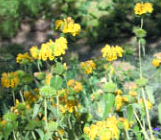
Phlomis fruticosa, Jerusalem sage.
Phlomis fruticosa
jerusalem sage

Evergreen perennial subshrub from 2 to 3 feet high and as wide. In spring, clear yellow flowers develop atop stems with whorls of gray, velvety, aromatic leaves. This is a great plant on slopes or combine with other dry-climate plants. Deadhead old flowers for rebloom. Provide good soil drainage and moderate but deep watering. Accepts full sun but prefers afternoon shade. Native to the Mediterranean.
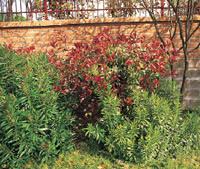
Photinia X fraseri, photinia.
Photinia X fraseri
photinia


Evergreen shrub or screen to 6 to 10 feet high. A special attraction is the new leaf growth in spring that is a glistening, coppery red on bright red stems. Foliage eventually turns a medium green. Clusters of white blossoms also put on a spring show. More mildew resistant than other photinias. Native to eastern Asia.
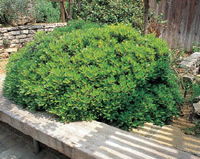
Pittosporum tobira 'Wheeler's Dwarf'.
Pittosporum tobira
mock orange, tobira


This evergreen shrub grows 6 to 10 feet high, with glossy green leaves to 4 inches long. Fragrant, white flower clusters bloom in spring. Gradually becomes a vigorous, sturdy, heavily branching foundation shrub. Prefers partial shade location with filtered sunlight, such as beneath a canopy tree. Native to Japan.
‘Wheeler’s Dwarf’ is much more compact to 2 feet high. Dense growth makes it a good choice as a foreground shrub. ‘Variegata’, variegated mock orange, is a combination of light green and white variegated foliage. It features low, compact-branching growth from 4 to 8 feet high.
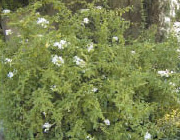
Plumbago scandens, white desert plumbago.
Plumbago scandens
white desert plumbago

Grows to 3 feet high and as wide, becoming a rambling, vining shrub. Glossy green, evergreen leaves turn red to purple with cold weather. Produces white, tubular flowers from spring into fall, attracting butterflies. Better appearance when provided with afternoon shade, such as in an eastern exposure. Native to southern Arizona and Mexico.
‘Summer Snow’ is an improved selection.
Prunus caroliniana ‘Compacta’
dwarf cherry laurel

Specially selected strain of Carolina laurel cherry, grown for its tight, compact growth habit. An evergreen, it grows to 4 feet high and as wide with glossy, deep green leaves. Small, creamy white flowers in March are followed by blackish red berries that attract birds. Best with afternoon shade in the Coachella Valley. Does not accept saline or alkaline soils. Hybrid of parents native to southern Appalachia.
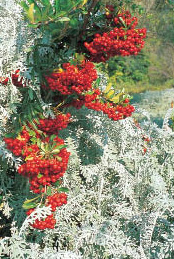
Pyracantha species, pyracantha.
Pyracantha crenatoserrata
pyracantha, firethorn

(P. fortuneana). A vigorous, thorny, upright shrub to 8 to 12 feet high with dark green leaves. Outstanding landscape interest throughout the year due to its clusters of white spring flowers and large, long-lasting, red berries in winter. Accepts espalier training. Native to China.
Many selections are available. ‘Graberi’ is more erect, with huge clusters of flowers and berries.
Pyracantha X ‘Santa Cruz Prostrata’
prostrate pyracantha

Unique prostrate growth habit allows this pyracantha to be used for ground cover, bank planting or as a low shrub. Grows from 2 to 4 feet high and up to 8 feet wide. Evergreen, with attractive, glossy, deep green foliage. Covers itself with masses of white flowers in spring followed by red berries in fall. Prune upright branches to maintain low-growing form.
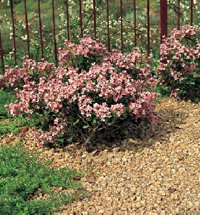
Raphiolepis indica, indian hawthorn.
Raphiolepis indica
indian hawthorn

(Rhaphiolepis indica). Evergreen shrub 3 to 4 feet high and 5 to 6 feet wide, with a dense, rounded form. From January to April, the dark green leaves are blanketed by magnificent clusters of flowers. Well drained soil is required. Accepts partial shade. Avoid overhead watering in sunny locations. Native to southern China.
Many cultivars are available: ‘Ballerina’, rosy pink; ‘Clara’, white; ‘Jack Evans’, bright pink; Spring RApture, rose-red flowers;‘Springtime’, deep pink.
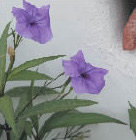
Ruellia brittoniana, ruellia.
Ruellia brittoniana
ruellia

Although dwarf forms are available, the full-size plant is a pleasure to grow, reaching 3 to 4 feet high and spreading at least as wide. Given the room and provided regular water, it can spread to fill a planting bed. The long, bronzy green leaves make a nice backdrop to the purple, trumpet-shaped flowers. Each bloom lasts a single day, but the shrub blooms throughout the warm season. For best appearance, plant where it will receive afternoon shade. Does best in well drained soil, but accepts clay soils. Native to Mexico.
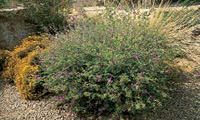
Ruellia peninsularis, Baja ruellia.
Ruellia peninsularis
baja ruellia


This is an evergreen shrub growing to 3 feet high, putting out a profusion of purple flowers in late spring and summer. Combine with yellow-flowering Encelia farinosa and red-flowering Salvia greggii for striking color combinations. Adapts well to heat, wind and reflected sun, which makes it a good poolside plant. Plants seldom need pruning except to thin old growth for renewal.
Salvia species
Salvia
Salvia is a large genus, with over 900 species world wide. For best results in the Valley, plant species that are adapted to our desert climate.
Hummingbirds love salvias, so desert gardeners are wise to include them in their gardens to attract these fascinating birds. Salvias come in a range of sizes. Some grow as low as 1 foot high, others up to 8 feet. Leaf color varies greatly as well, from silvery white, to olive, to lush deep green. All grow rapidly, and benefit from pruning (cutting back) after flowering has ceased. Select species carefully to suit the space you have available. Here are just a few salvias known to do well in the Valley.
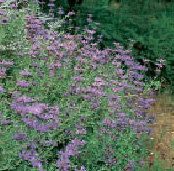
Salvia clevelandii, chaparral sage.
Salvia clevelandii
chaparral sage, cleveland sage

This sage is native to California’s rugged coastal chaparral, and is surprisingly well adapted to the tougher climates of desert areas. Most plants reach 4 feet high and 5 feet or more wide. Fragrant blue flowers develop in whorls on stems in spring. Deadhead old flower stems in summer after bloom period has passed to renew growth. Well-drained soil recommended. Accepts some shade. Gray-green foliage blends well with many desert natives, and produces a pleasant, musky fragrance when brushed. Plants sometimes scent the air after a vigorous rain. Recently introduced cultivars featuring different shades of purple flowers are available.
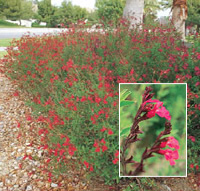
Salvia greggii, autumn sage.
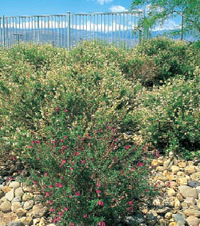
Salvia greggii, autumn sage (white and red selections).
Salvia greggii
autumn sage

This evergreen subshrub grows 2 to 3 feet high and as wide. Effective when planted in masses, the flower spikes in shades of scarlet-red and magenta attract hummingbirds. Finches enjoy the seeds. Afternoon shade is appreciated in low-elevation deserts. Prune old flowering wood after blooms cease to create new flush of growth. Native to Texas and Mexico.
Many cultivars are available, including ‘White’, with elongated white flowers; and ‘Sierra Linda’ (red flowers), which is heat tolerant.
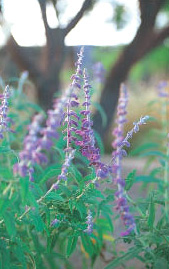
Salvia leucantha, Mexican bush sage.
Salvia leucantha
mexican bush sage

This evergreen shrub grows from 2 to 4 feet high with an often greater spread. Casual, graceful mounding growth habit is well-suited to a natural garden design. Plant in masses for a striking flower displays. Long, slender, velvety purple spikes bloom late summer well into fall, sometimes into winter. Cut back plants after flowering in late winter for fresh growth in spring. Best if given afternoon shade. Native to Mexico.
Senna species
Senna
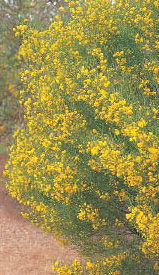
Senna species, senna.
(Cassia). This group of shrubs are star performers for the arid West, producing yellow fragrant flowers in abundance from late winter into the spring months. They are low water users once they’re established, and thrive in full sun. Depending on species, plants grow from 5 to 6 feet high or more, with an equal spread. Foliage color and type varies with each species.
All Senna species can be controlled by natural thinning and topping. Remove seed pods after flowering for a neater appearance. Pods have been used medicinally for eons, but some species are toxic. Plant in well-drained soil. Prune sennas after flowering has passed. This helps remove seed pods and keeps plants in proportion.
Note: Many species within this genus were formerly named Cassia. Nurseries may carry these plants labeled as Cassia.
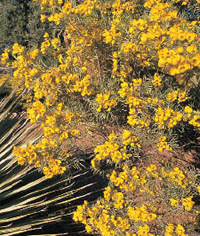
Senna artemisioides, feathery senna.
Senna artemisioides
feathery senna


(Cassia artemisioides). Grows rapidly from 4 to 6 feet high and as wide with an upright, rounded form. Makes a fine background for tall perennials or dwarf shrubs. The evergreen, gray-green, feathery leaves blend perfectly with the yellow flowers that appear late winter and spring. Prune in fall or in cool weather following flowering. Native to Australia.

Salvia leucantha, Mexican bush sage.
Senna artemisioides filifolia
desert senna

(Cassia nemophila). This variety has greener silvery foliage and is larger than Senna artemisioides. Yellow flowers that bloom in late winter and spring are followed by brown seed pods. Grows 4 to 8 feet high with an equal spread. Space 8 to 10 feet apart to allow the plant to grow naturally, which will also yield the most profuse flowers. Remove seed pods with a light natural pruning or knock them off. More hardy to cold than S. artemisioides. Native to Australia.
Senna artemisioides
petiolaris
silver senna

(Cassia phyllodinea). Gray-green, sickle-shaped leaves shimmer in the wind. One of the most early flowering sennas, it sometimes begins blooming in December, and often continuing into April. Evergreen, with mature size of 6 feet high with equal spread. Growth is more compact so heavy shearing or pruning is not usually required. Prune when flowering has ceased and while weather is still cool. Native to Australia.
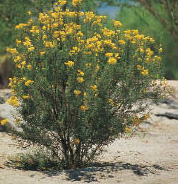
Senna wislizenii, shrubby senna.
Senna wislizenii
shrubby senna

(Cassia wislizenii). Stiff, gray-green, 1-inch leaves are winter deciduous. Spring growth has tinge of bronze that creates a striking effect. Grows 6 feet high and 8 feet wide. Bright yellow flower clusters bloom June to September, rather than winter months, as other Senna described here. This is a tough plant that tolerates salinity, alkalinity, some flooding and even neglect. Plant in background where loss of leaves in winter is not notable. Early growth is slow, but after a season or two plants develop more vigor. Native to Sonoran and Chihuahuan Deserts.
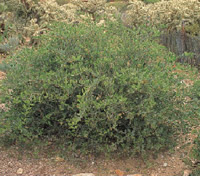
Simmondsia chinensis, jojoba.
Simmondsia chinensis
jojoba

This distinctive shrub is native to the Sonoran Desert, growing 4 to 8 feet high with an equal spread. Gray-green, leathery, evergreen leaves are dense, producing mounding growth adapted to informal and formal designs. Use as a foundation plant, hedge (accepts some shearing) , screen or background shrub. Male and female flowers are borne on different plants, so both must be present for the female to produce the seeds, which have many commercial uses. Little or no pruning required. Plant in well-drained soil.
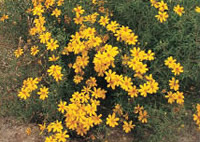
Tagetes lemmonii, mountain marigold.
Tagetes lemmonii
mountain marigold


This mounding shrub from 3 to 4 feet high can be recognized by its golden yellow, daisylike flowers that develop in late fall. If not damaged by frost, flowering continues into spring. Finely divided, light green foliage is strongly aromatic. Cut foliage back by half in early summer to develop sturdy growth to support flowers. Native to southeastern Arizona.
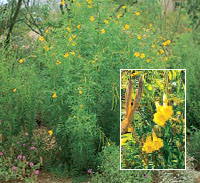
Tecoma stans, yellow trumpet flower.
Tecoma stans
yellow trumpet flower

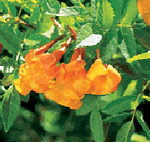
Tecoma 'Orange Jubilee'.
(Stenolobium stans). Large, vigorous plant useful as shrub, espalier or background. In warm microclimates with time and training, it can become a small tree with a potential to reach 15 to 20 feet high. Yellow clusters of trumpet-shaped flowers adorn the plant from June to February. Provide full sun and heat, with moderate water. Prune to control the vigorous growth. Native to Mexico and West Indies.
Tecoma ‘Orange Jubilee’ is similar in size and form but produces an abundance of bright orange, tubular flowers.
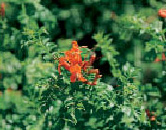
Tecomaria capensis, cape honeysuckle.
Tecomaria capensis
cape honeysuckle

Large, upright, evergreen shrub 6 to 10 feet high, or a spreading, non-climbing vine to 20 feet. Grown for its glossy green leaves and brilliant clusters of orange-red, trumpet-shaped flowers that bloom in winter and spring. This is a tough plant that adapts to a range of growing conditions. Rapid growth rate requires pruning to control during the warm season, which the plant accepts without problems. Recovers rapidly in spring if damaged by frost. Native to South Africa.
Thevetia peruviana
lucky nut


In warm microclimates, this shrub can be pruned to become a small umbrella-shaped tree from 15 to 20 feet high. Typically, however, it is a large shrub to 8 feet high and as wide. Strap-shaped leaves 3 to 6 inches long and 1/2 inch wide are a rich yellowish green. Foliage is dense and provides an excellent backdrop to the mildly fragrant flowers. Yellow or peach-colored, trumpet-shaped flowers to 3 inches in diameter adorn the plant spring into fall, and year--round in mild years. Soak the root zone deeply every week or two in summer for best performance. Young plants are hardy to 25°F. Prune to remove frost-damaged stems in early spring. Native to tropical America.
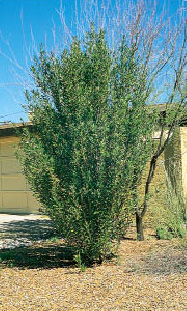
Vauquelinia californica, Arizona rosewood.
Vauquelinia californica
arizona rosewood

Large evergreen shrub to small tree with one to several trunks. Grows at a moderate rate 10 to 15 feet high, spreading from 5 to 15 feet. Linear, leathery leaves up to 4 inches long are dark green above and velvety gray beneath. Large clusters of small white flowers appear on branch tips in late spring. A rugged and enduring plant with rich textured foliage and an ornamental character. An excellent alternative to oleander. Native to Baja California and, what was once Alta California, now Arizona.
Viburnum tinus
laurustinus


A dense, evergreen shrub from 6 to 12 feet high and half as wide. Luxuriant deep green foliage is the background for large quantities of striking white flowers blushed with pink during fall and winter. Tends to develop mildew in heavy shade; locate in partial shade and out of afternoon sun. Native to the Mediterranean.
‘Robustum,’ roundleaf laurustinus, is more mildew resistant, has coarser leaves and whiter flowers. Often used as a narrow patio tree.
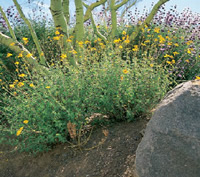
Viguiera deltoidea, golden eye.
Viguiera deltoidea
golden eye


Outstanding small flowering shrub to 3 feet high and as wide. The grayish green leaves are covered with dense hairs, giving them an interesting texture. Conspicuous yellow daisy flowers offer bright splashes of color from spring into summer. Seeds are enjoyed by birds. Native to the Sonoran Desert.
Xylosma congestum
xylosma

(X. senticosum). Versatile, medium-sized evergreen shrub 6 to 10 feet high. Also can be grown as a multiple-trunked tree, espalier, screen or clipped hedge. Arching branches are attractive on upright growth habit. New foliage has reddish tint, which then matures into glossy light green. Flowers are insignificant. Easy to control and accepts trimming well. Accepts some shade. Native to China.